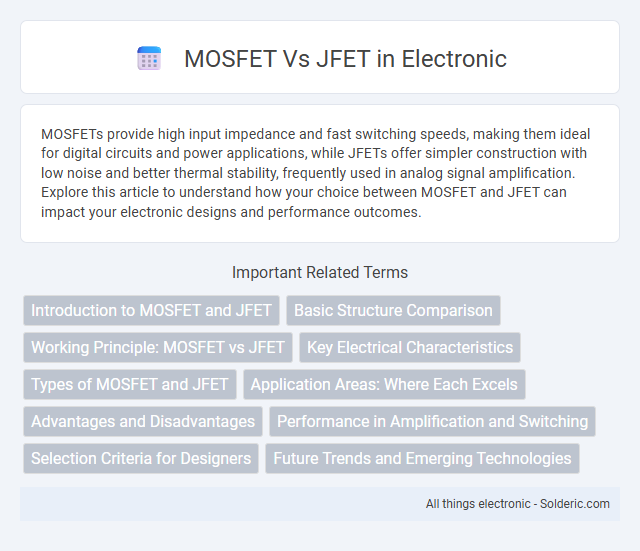MOSFETs provide high input impedance and fast switching speeds, making them ideal for digital circuits and power applications, while JFETs offer simpler construction with low noise and better thermal stability, frequently used in analog signal amplification. Explore this article to understand how your choice between MOSFET and JFET can impact your electronic designs and performance outcomes.
Comparison Table
| Feature | MOSFET | JFET |
|---|---|---|
| Full Name | Metal-Oxide-Semiconductor Field-Effect Transistor | Junction Field-Effect Transistor |
| Control Terminal | Gate insulated by oxide layer | Gate forms a PN junction with channel |
| Input Impedance | Very high (10^9 to 10^12 ohms) | High (10^7 to 10^9 ohms) |
| Voltage Requirement | Voltage-driven device | Voltage-driven device |
| Current Flow | Controlled by gate voltage producing channel conductivity | Controlled by gate voltage reverse-biasing junction |
| Channel Type | Can be N-channel or P-channel | Can be N-channel or P-channel |
| Switching Speed | High-speed switching capability | Moderate switching speed |
| Noise Generation | Low noise | Very low noise, preferred in low-noise amplifiers |
| Power Consumption | Minimal gate current, very low power consumption | Minimal gate current, low power consumption |
| Applications | Switching devices, amplifiers, digital circuits | Low-noise amplifiers, analog switches, voltage-controlled resistors |
| Fabrication Complexity | More complex due to oxide layer | Simpler fabrication |
Introduction to MOSFET and JFET
MOSFETs (Metal-Oxide-Semiconductor Field-Effect Transistors) use an insulated gate to control current flow, exhibiting high input impedance and fast switching capabilities, making them ideal for digital circuits and power applications. JFETs (Junction Field-Effect Transistors) rely on a reverse-biased PN junction to regulate current, offering low noise and simpler construction, commonly used in low-noise analog circuits and amplifiers. Both devices operate as voltage-controlled transistors but differ fundamentally in gate structure and operational characteristics, influencing their respective applications in electronics.
Basic Structure Comparison
MOSFET features an insulated gate with a thin oxide layer separating it from the semiconductor channel, allowing voltage-controlled operation with high input impedance. JFET has a gate formed by a p-n junction directly contacting the channel, enabling current-controlled operation with lower input impedance. Your choice depends on the required voltage control precision and input impedance in your electronic circuit design.
Working Principle: MOSFET vs JFET
MOSFETs operate by varying the voltage applied to the metal-oxide gate terminal, which controls the conductivity between the drain and source channels through an insulating oxide layer, enabling high input impedance and fast switching speeds. JFETs function by applying voltage to the gate terminal which controls the width of the conductive channel formed by a p-n junction, modulating current flow based on depletion regions. The key difference lies in MOSFETs using a voltage-controlled insulated gate allowing enhancement-mode operation, while JFETs use a junction gate with typically depletion-mode characteristics.
Key Electrical Characteristics
MOSFETs feature high input impedance and fast switching speeds, making them ideal for power amplification and switching applications, while JFETs offer low noise and a normally-on operation suitable for analog signal amplification. MOSFETs operate with voltage-controlled gates, whereas JFETs use reverse-biased junctions to control current flow, impacting input capacitance and gate leakage current. Your choice depends on required gate control voltage levels, noise considerations, and switching efficiency.
Types of MOSFET and JFET
MOSFETs are primarily classified into enhancement-mode and depletion-mode types, with N-channel and P-channel variants based on the charge carrier type, while JFETs mainly come as N-channel or P-channel depletion-mode devices. Enhancement-mode MOSFETs require a positive gate-to-source voltage to conduct, contrasting with depletion-mode MOSFETs and JFETs that conduct at zero gate bias and use gate voltage to control current flow. MOSFETs offer higher input impedance and faster switching compared to JFETs, making their types suitable for different analog and digital circuit applications.
Application Areas: Where Each Excels
MOSFETs excel in high-speed switching applications, such as power supplies, motor controllers, and digital circuits, due to their low gate drive power and fast switching capabilities. JFETs are preferred in low-noise analog circuits, RF amplifiers, and signal processing because of their superior linearity and low distortion. Your choice depends on whether high-frequency switching efficiency or low-noise amplification is the priority.
Advantages and Disadvantages
MOSFETs offer high input impedance and fast switching speeds, making them ideal for digital circuits and power applications, but they can be more susceptible to damage from static electricity due to their thin oxide layer. JFETs provide low noise and better thermal stability, suitable for analog applications, yet they typically have lower input impedance and slower switching compared to MOSFETs. Understanding these advantages and disadvantages helps you choose the right transistor for your specific electronics project requirements.
Performance in Amplification and Switching
MOSFETs offer higher input impedance and faster switching speeds compared to JFETs, making them ideal for high-frequency amplification and efficient digital switching applications. JFETs provide lower noise levels and better linearity, which enhances your analog signal amplification quality in sensitive circuits. Choosing between MOSFET and JFET depends on whether you prioritize speed and efficiency or noise performance and linearity in your design.
Selection Criteria for Designers
Designers select MOSFETs for high-speed switching and low power consumption applications due to their high input impedance and faster switching capabilities. JFETs are preferred when low noise and simple gate control are essential, especially in analog circuits requiring stable operation with minimal distortion. Your choice depends on the specific requirements of gain, voltage handling, and thermal performance in the intended application.
Future Trends and Emerging Technologies
Future trends in MOSFET technology emphasize scaling down with advanced gate dielectrics like high-k materials, enabling higher performance and lower power consumption in nanoscale devices. JFETs, while less prevalent, find emerging applications in high-frequency and low-noise analog circuits due to their superior linearity and low capacitance. Integration of MOSFETs in flexible electronics and the development of novel 2D material-based transistors forecast significant advancements impacting next-generation semiconductor devices.
MOSFET vs JFET Infographic

 solderic.com
solderic.com